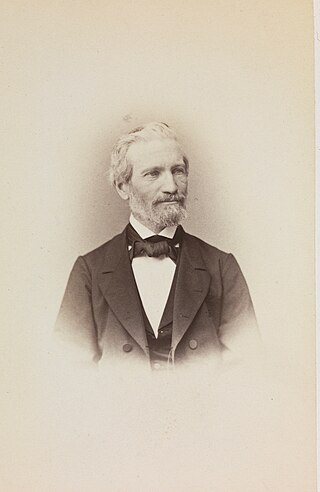Related Research Articles
Milorg was the main Norwegian resistance movement during World War II. Resistance work included intelligence gathering, sabotage, supply-missions, raids, espionage, transport of goods imported to the country, release of Norwegian prisoners and escort for citizens fleeing the border to neutral Sweden.

Carl Joachim Hambro was a Norwegian journalist, author and leading politician representing the Conservative Party. A ten-term member of the Parliament of Norway, Hambro served as President of the Parliament for 20 of his 38 years in the legislature. He was actively engaged in international affairs, including work with the League of Nations (1939–1940), delegate to the UN General Assembly (1945–1956) and member of the Norwegian Nobel Committee (1940–1963).

Peter Christen Asbjørnsen was a Norwegian writer and scholar. He and Jørgen Engebretsen Moe were collectors of Norwegian folklore. They were so closely united in their lives' work that their folk tale collections are commonly mentioned only as "Asbjørnsen and Moe".

Grini prison camp was a Nazi concentration camp in Bærum, Norway, which operated between 1941 and May 1945. Ila Detention and Security Prison is now located here.

Bergen Cathedral School is an upper secondary school in Bergen, Norway. Located in the city centre, next to Bergen Cathedral, the school has about 850 students, 95 full-time teachers, and 5 administration personnel, including the headmaster, Karen Kristine Rasmussen.

Lars Christensen was a Norwegian shipowner and whaling magnate. He was also a philanthropist with a keen interest in the exploration of Antarctica.

Jens Thiis was a Norwegian art historian, conservator and a prominent museum director. He was conservator at the Nordenfjeld Industrial Arts Museum in Trondheim beginning in 1895 and director of the National Gallery in Oslo from 1908 to 1941.

Nicolay Nicolaysen was a Norwegian archaeologist and Norway's first state employed antiquarian. He is perhaps best known for his excavations of the ship burial at Gokstad in 1880.
Einar Thorsrud was a Norwegian psychologist, researcher and professor at the Norwegian Institute of Technology in Trondheim and University of Oslo, who is known for his work in the field of organizational development (OD), particularly in the development of theory around participative work design structures. Much of his work was done in collaboration with Eric Trist and/or Fred Emery. Thorsrud has been Research Director of the Norwegian Work Research Institute in Oslo, Norway.

Thorleiv Bugge Røhn was a Norwegian Army officer, who as a gymnast was a member of the team that won the gold medal in the team competition at the 1906 Intercalated Games in Athens, Greece.

Olaf Olsen Norli was a Norwegian bookseller and publisher.

Ole Hartvig Nissen was a Norwegian philologist and educator. He founded Nissen's Girls' School in Christiania in 1849. In 1865 he became director-general in the Ministry of Education, while remaining one of three joint headmasters of Nissen's Girls' School until 1872. In 1873 he was appointed to the prestigious position as rector of Oslo Cathedral School.
Tanums store rettskrivningsordbok is a Norwegian Bokmål dictionary. It was first published by the publishing house Johan Grundt Tanums forlag in 1940 as Norsk Rettskrivningsordbok. The 10th and latest edition was published in 2015.
Otto Carl Robert von Rosen was a Swedish military officer and sport shooter who participated in sabotage attacks during the First World War.

Johan Olaus Søhr MVO was a Norwegian jurist and police officer. Commonly known as Joh. Søhr.
Walter von Gerich was a Finnish civil servant and later an agent in German pay during World War I.

Nidaros was a Norwegian newspaper, published in Trondheim in Sør-Trøndelag.

Stadsbygd is a former municipality in the old Sør-Trøndelag county, Norway. The municipality existed from 1838 until its dissolution in 1964. The 137-square-kilometre (53 sq mi) municipality existed on the southern part of the Fosen peninsula, along the Trondheimsfjorden in what is now the municipality of Indre Fosen in Trøndelag county. The administrative centre was the village of Stadsbygd, just north of the Stadsbygd Church.

Nils Larsen was a Norwegian pianist, composer, and pedagogue. He was one of Norway's leading pianists before the Second World War and was an influential promoter of Norwegian piano performance.

Andreas Christian Møller was a Norwegian lathe operator and teacher of the Deaf who founded the first school for the Deaf in Norway. Møller is therefore considered the "father of Deaf education" in Norway. The AC Møller Sign Language Center bears his name.
References
- ↑ Haarstad, Gunnar (1988). I hemmelig tjeneste (in Norwegian). Oslo: Aschehoug. p. 57.
- 1 2 Hobson, Rolf; Kristiansen, Tom (2001). Norsk forsvarshistorie (in Norwegian). Vol. 3. Bergen: Eide forlag. p. 133.
- 1 2 Jørgensen, Jørn-Kr. "Johan Søhr". In Helle, Knut (ed.). Norsk biografisk leksikon (in Norwegian). Oslo: Kunnskapsforlaget. Retrieved 20 February 2010.
- 1 2 Søhr, Joh. (1938). "Baron von Rosens mystiske ekspedisjon". Spioner og bomber. Fra opdagelsespolitiets arbeide under verdenskrigen (in Norwegian). Oslo: Johan Grundt Tanum. pp. 35–46.
- 1 2 Søhr, Joh. (1938). "Den Rautenfelske bombesak". Spioner og bomber. Fra opdagelsespolitiets arbeide under verdenskrigen (in Norwegian). Oslo: Johan Grundt Tanum. pp. 72–98.
- ↑ Søhr, Joh. (1938). "Spioner i Bergen og Trondhjem". Spioner og bomber. Fra opdagelsespolitiets arbeide under verdenskrigen (in Norwegian). Oslo: Johan Grundt Tanum. pp. 108–134.
- ↑ Søhr, 1938 pp. 148-151
- ↑ Søhr, 1938 pp. 135-136